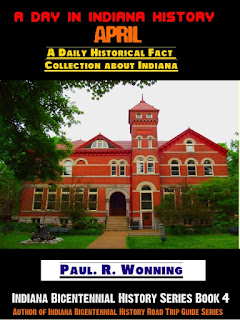This Day in Indiana History - April 15, 1861 - Governor Oliver P. Morton Calls for 10,000 Volunteers
 | |
|
On April 12, 1861, Confederate troops fired on Fort Sumter in South Carolina. Three days later President Lincoln called on the states loyal to the Union to raise 75,000 troops to put down the rebellion. Indiana Oliver P. Morton, a long-time Lincoln supporter, sent President Lincoln a telegraph pledging to raise 10,000 troops for the Union.
Anticipation of War
Morton had anticipated war between the slave and free state. Prior to the outbreak of war, he established, without legislative approval, a state arsenal. This arsenal eventually consisted of 700 men producing ammunition for the war effort. At the beginning of his tenure of governor in January, 1861 he appointed men to state government positions that opposed any compromise with the southern states.
War Preparations
Indiana was not prepared for the war effort. It would be difficult to borrow money, as its credit rating was still poor from its financial problems following the Mammoth Internal Improvement Act of 1836 and the following Panic of 1837 that bankrupted the state. As the war effort began, the Governor faced the mammoth task of recruiting and paying soldiers, supplying them with arms and ammunition and supplies the soldiers needed to train. He transformed the Indiana State Fairgrounds into a military camp, appointing Democrat Lew Wallace to oversee the transformation. Wallace was equal to the task and had the new camp ready for the first recruits in just a few days. The legislature voted to provide funds for the governor to conduct the war effort. Morton appointed another Democrat, Robert Dale Owen, to find arms for the soldiers. Morton, though most of his appointments were to Republicans loyal to him, appointed enough prominent Democrats to high profile positions to cement his claim of a bipartisan war effort.
Lincoln's Call for Troops
Lincoln initially called for 75,000 troops to fight the war. Indiana's allotment was set at six regiments totaling 4,683 men. Indiana residents responded to Morton's call with 12,000 recruits by the end of April. Owen's monumental efforts led to the purchase of enormous quantities of arms, including over 30,000 Enfield rifles, a fast loading, and highly accurate weapon. Indiana would eventually send 196,363 Hoosiers to war in both the Army and the Navy, the second highest proportion of troops of any state in the Union. This amounted to about fifteen percent of the state's population. On May 30, 1861, the first Hoosier soldiers marched off to war.
Comments
Post a Comment